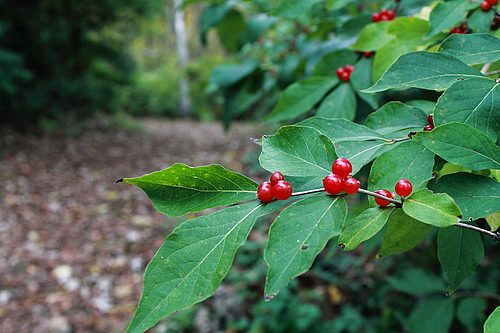
It is autumn in the Arb, and the cardinals here are perfectly suited to the seasonal shift in color scheme. Amid the oranges, reds, and harvest hues of October in the Midwest, they can be easy to miss; another flash of scarlet between branches of brilliantly pigmented maple leaves. But though these red feathered friends are a welcome sight to any Arb visitor, and nearly as iconic as the leaves that camouflage them, their vivid plumage is also indicative of a more sinister presence in the forest: invasive species.
The Amur Honeysuckle is a non-native invasive plant common in the Arb whose small red berries are a favorite for cardinals due to their late-season abundance. While these berries have little nutritional value for cardinals compared to native berries, they are bursting with pigments called carotenoids (the same carotenoids that are responsible for our beloved fall foliage). It is the specific carotenoid called rhodoxanthin that colors cardinals crimson.
So why the fuss? How does the brightening of a cardinal’s feathers demonstrate the dangers of an invasive species? Essentially, the honeysuckle berries are luring the cardinals into what is called an “evolutionary trap”. Vivid plumage in a cardinal, especially the males, is typically a positive fitness signal indicating prime mating material. However, because these bright red cardinals are getting their vivacity by consuming the less-nutritional honeysuckle berries, they are falsely advertising their own evolutionary prowess to potential mates. Thus, the honeysuckle is not only providing nutritionally-inferior food to the birds, it is also tricking the females into mating with less viable males.
Nevertheless, the cardinals in the Arb are in no immediate threat of endangerment, and the Carleton Arboretum crew is working hard to control the tenacious encroachment of the Amur honeysuckle. But next time you are out walking among the carotenoids and catch a glimpse of red feathers in the bushes, take a moment to appreciate the vast interconnectedness of the biotic community around you, and the innumerable impacts we living things have on one another.
–Kate Nootenboom ‘20, for the Cole Student Naturalists
Add a comment